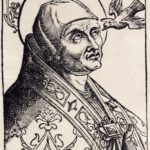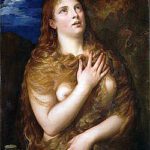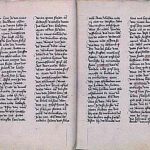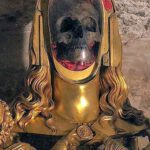Maria Magdalena komt ook voor in sommige apocriefe teksten. Er is zelfs een evangelie van Maria. Hieronder vindt u meer details.
Apocriefe teksten in Nag Hammadi
De Bijbel is niet de enige bron over de achtergrond van Maria Magdalena.
In 1945 stuitten twee mannen in Nag Hammadi, in het zuiden van Egypte, op een verzegelde keramische pot. Binnenin ontdekten ze een schat aan oude papyrusboeken. Hoewel ze nooit zoveel publieke aandacht hebben gekregen als de Dode Zee rollen1, blijken deze eigenlijk veel belangrijker te zijn voor het schrijven van de geschiedenis van het vroege christendom.
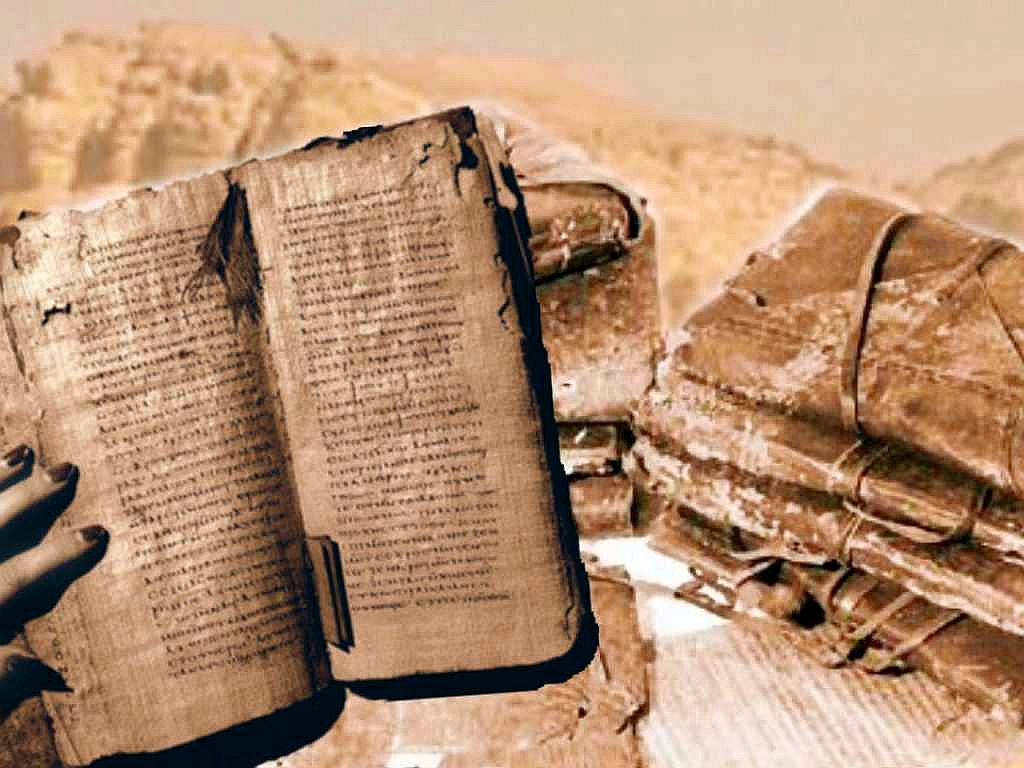
De Nag Hammadi-teksten vertellen ons over vroege christenen. Ze waren geschreven in het Koptisch, de taal van het vroegchristelijke Egypte. Aangezien de meeste oude christelijke teksten verloren zijn gegaan, was deze ontdekking uitzonderlijk.
De ontdekking omvat het Evangelie van Thomas, het Evangelie van Filippus en de Handelingen van Petrus. Geen van deze teksten is in de Bijbel opgenomen, omdat de inhoud niet in overeenstemming was met de christelijke leer, en ze worden apocrief2 genoemd. Ze hebben de neiging zich te concentreren op dingen waarover men niet in de Bijbel leest. De nieuwtestamentische evangeliën melden bijvoorbeeld dat Jezus na de opstanding enige tijd met de discipelen sprak, maar dat je niet veel leert over wat hij zei.
In de evangeliën van Nag Hammadi kun je wel lezen wat hij zei.
Hoewel het geen bijbelse teksten zijn, geloven experts nog steeds dat ze ons belangrijke inzichten in de christelijke geschiedenis geven. In deze apocriefe teksten kunnen we authentieke overleveringen over Jezus vinden die om de een of andere reden niet in het Nieuwe Testament zijn opgenomen.
Prominente discipel of sleutelfiguur
Ze zijn ook (voor het eerst in honderden jaren) een nieuwe bron van informatie over Maria Magdalena.
Ze verschijnt heel vaak als een van de prominente discipelen van Jezus. In bepaalde teksten waarin Jezus met zijn discipelen in gesprek is, stelt Maria Magdalena veel weloverwogen vragen. Terwijl de andere discipelen soms in de war lijken, is zij degene die het lijkt te begrijpen.
Een van de documenten die in Nag Hammadi zijn ontdekt, is het evangelie van Filippus, waarin Maria Magdalena een sleutelfiguur is.
Dit evangelie is de oorzaak geweest van een van de meest controversiële beweringen die ooit over haar zijn gedaan. Tijdens hun lange verblijf in de woestijn werden sommige boeken aangevreten door mieren. Die mieren maakten juist in dit evangelie een gat op een zeer cruciale plaats. De tekst zegt:
“En de metgezel van de […] Maria Magdalena. […] hield meer van haar dan van alle discipelen, en kuste haar vaak op haar […]. De rest van de discipelen [… ] Ze zeiden tegen hem: “Waarom hou je meer van haar dan van ons allemaal?” De Heiland antwoordde en zei tegen hen: “Waarom hou ik niet van je zoals zij? Wanneer een blinde en een ziende samen in duisternis verkeren, verschillen ze niet van elkaar. Als het licht komt, zal degene die ziet het licht zien, en degene die blind is zal in de duisternis blijven.”
De lacune die verbergt waar Jezus Maria kuste, heeft geleerden al tientallen jaren gekweld.
Waren Jezus en Maria Magdalena geliefden?
Sommige geleerden hebben de kus in een meer spirituele zin geïnterpreteerd en zien kussen als een symbool voor een intieme ontvangst van het woord van God. Het beeld van Jezus en Maria, bezig met mond-op-mond-contact, suggereert niet noodzakelijkerwijs seksualiteit, maar de overdracht van goddelijke kennis.
Maria Magdalena verschijnt in deze tekst ook niet alleen als de discipel van wie hij het meest hield, maar ook als een symbolische figuur van hemelse wijsheid. Deze verhalen over Maria – als Jezus’ naaste metgezel en een symbool van hemelse wijsheid – staan in schril contrast met de Maria Magdalena van de populaire verbeelding.
“Apocrief” kreeg een zeer negatieve connotatie, vooral in vergelijking met de Bijbel. Het betekent vaak dat het niet gelezen mag worden, niet serieus genomen, niet overwogen, als niet waar. De inhoud van deze boeken wordt door veel mensen als een legende beschouwd.
Kunnen we dus het evangelie van Filippus geloven? Was Maria werkelijk de naaste metgezel van Jezus?
Welnu, daar is nog een ander bewijs voor, en een deel ervan staat zelfs in de Bijbel zelf.

Belangrijke momenten
De Bijbel zegt dat Maria Magdalena aanwezig was bij de twee belangrijkste momenten in het verhaal van Jezus: de kruisiging en de opstanding. Maria Magdalena was bij beide evenementen een prominente figuur. Er wordt ons verteld dat zij een van de vrouwen was die de wacht hield bij het graf van Jezus.
Het was in die tijd gebruikelijk dat Joodse vrouwenlichamen klaarmaakten voor de begrafenis. Lijken werden als onrein beschouwd en daarom was het altijd de taak van een vrouw om ze te behandelen.
Als Maria naar het graf gaat, is het lichaam van Jezus daar niet meer. Het meest volledige verslag van de rol van Maria na de ontdekking van het lege graf staat in het evangelie van Johannes. Ze is in shocktoestand en rent naar de plaats waar de discipelen zich hebben verzameld om hen het nieuws te vertellen. Als ze verslag uitbrengt aan de discipelen, wordt ze niet geloofd.
Petrus en een andere discipel keren met haar terug naar het graf om het zelf te zien. Als ze binnenkomen, reageert Petrus met woede en ontzetting op de aanblik van het weggegooide linnen grafkleed. Maar de andere discipel begrijpt wat er is gebeurd en concludeert dat Jezus uit de dood moet zijn opgestaan.
Grootste moment
De twee vertrekken zonder achterom naar Maria te kijken. Dan gebeurt er nog iets buitengewoons.
Het is het grootste moment van Maria Magdalena. Maria is alleen als iemand haar vraagt waarom ze huilt. Ze gelooft dat het de tuinman is en zegt: “Ze hebben het lichaam van mijn heer meegenomen en ik weet niet waar het is“. De figuur zegt haar naam. En dan ziet ze Jezus. Ze is overweldigd en zegt “Meester!” en gaat naar voren om hem te bereiken, maar hij houdt haar tegen. Hij zegt “Raak me niet aan“. In plaats daarvan moet ze naar de anderen gaan en hen vertellen dat hij uit de dood is opgestaan. Het is een geweldig moment. Jezus staat voor haar, maar hij is buiten haar bereik. We kunnen niet zeggen of Jezus echt voor haar stond, of dat Maria gewoon geloofde dat ze hem had gezien. Maar hoe dan ook, op dit ene moment bracht Maria’s ervaring de beweging in een belangrijke nieuwe richting.
Er ontwikkelde zich een nieuw concept dat niets te maken had met wat Jezus zelf predikte.
Het is het concept dat Jezus niet stierf – of dat hij stierf, maar werd opgewekt uit de dood. Dat is in feite een groot succes voor de prille beweging (volgers van Jezus) en de persoon die dit verklaart is Maria Magdalena!
De opstanding van Jezus was het keerpunt voor het christendom. Toen veranderde een kleine beweging naar een geheel nieuwe religie. En Maria Magdalena was een sleutelfiguur in deze verandering.
Je zou dus kunnen denken dat Maria op zijn minst erkend zou worden als een apostel – een van de eerste missionarissen die de religie stichtte – aangezien ze lijkt te voldoen aan alle criteria die in de Bijbel staan.
Het evangelie van Maria
De reden waarom ze dat niet is, ligt misschien in een andere lang verloren gewaande apocriefe tekst.
Op een bazaar in Caïro in 1896 kwam een Duitse geleerde toevallig een merkwaardig papyrusboek tegen. Gebonden in leer en geschreven in het Koptisch, was dit het evangelie van Maria. Net als de boeken die in Nag Hammadi zijn gevonden, wordt ook het evangelie volgens Maria Magdalena als een apocriefe tekst beschouwd.
Het verhaal begint enige tijd na de opstanding. De discipelen hebben net een visioen van Jezus gehad. Jezus heeft zijn discipelen aangemoedigd om erop uit te gaan en zijn leringen aan de wereld te verkondigen, maar ze zijn bang om dat te doen omdat hij ervoor is vermoord. Ze zeggen “als ze hem hebben vermoord, gaan ze ons ook vermoorden“. Het is Maria die naar voren stapt en zegt: “Maak je geen zorgen, hij beloofde dat hij bij ons zou zijn om ons te beschermen”.
Apostel van de apostelen
Op dit punt vraagt Petrus aan Maria om hen enkele dingen te vertellen die zij misschien heeft gehoord, maar die de andere discipelen niet hebben gehoord. Ze zegt “Ja, ik zal je vertellen wat voor je verborgen is“. Ze vertelt over een visioen dat ze van Jezus had en een gesprek dat ze met hem had. Zoals het evangelie zegt, vertelt Maria vervolgens de details van dit gesprek, dat te maken heeft met spirituele ontwikkeling en de levenslange strijd van de ziel met het kwaad.
Op dit punt ontstaat er controverse, en Andreas komt tussenbeide en zegt: “Nou, ik weet niet wat de rest van jullie denkt, maar deze dingen lijken me erg vreemd, en het lijkt erop dat ze ons dingen vertelt die anders zijn dan die van de Heiland.”
Petrus stemt dan in en hij zegt: “Moeten we ons nu allemaal omdraaien en naar haar luisteren? Zou Jezus privé met een vrouw hebben gesproken in plaats van openlijk met ons? Had hij haar liever dan ons?“
Matheus verdedigt Maria en onderdrukt Petrus’ aanval op haar. In de tekst lijkt het probleem van Petrus te zijn dat Jezus Maria verkoos boven de andere discipelen om zijn leringen te interpreteren. Petrus ziet Maria als een rivaal voor de leiding van de groep zelf.
Petrus hoefde niet bang te zijn. De meeste mensen zien Petrus als de rots waarop de kerk is gebouwd. Hij is de belangrijkste discipelfiguur, en Maria Magdalena is een soort bijfiguur in de cast van personages.
Een van de absoluut fascinerende dingen van het evangelie van Maria is dat het ons echt vraagt om dat verhaal over de christelijke geschiedenis te heroverwegen: begrepen alle discipelen het? Hebben ze de waarheid echt begrepen en gepredikt? Misschien was het evangelie van Maria gewoon te radicaal. Het presenteert Maria als een leraar en spirituele gids voor de andere discipelen. Ze is niet zomaar een discipel; zij is de apostel van de apostelen.
“Maria Magdalena is een van de eerste volgelingen van Jezus” zegt Robert Cargill, assistent-professor klassiekers en religieuze studies aan de Universiteit van Iowa en redacteur van Biblical Archaeology Review.
Ze werd genoemd in de evangeliën, dus ze was duidelijk belangrijk. Er waren blijkbaar honderden, zo niet duizenden volgelingen van Jezus, maar de meeste van hun namen kennen we niet. Dus het feit dat ze wordt genoemd, is een groot probleem.
Na de kruisiging van Jezus – waarvan ze samen met enkele andere vrouwen getuige was vanaf de voet van het kruis – en nadat al zijn mannelijke discipelen waren gevlucht, speelde ook Maria Magdalena een sleutelrol in het verhaal van de verrijzenis. Volgens de evangeliën bezocht ze het graf van Jezus op paaszondag, alleen (volgens het evangelie van Johannes) of met andere vrouwen, en vond het graf leeg. “Het zijn de vrouwen die het de discipelen gaan vertellen“, legt Cargill uit. “Zij zijn degenen die ontdekten dat hij was opgestaan, en dat is veelbetekenend.”
In het Johannes-evangelie verschijnt Jezus na zijn opstanding eigenlijk alleen aan Maria Magdalena, en instrueert haar om zijn discipelen te vertellen over zijn terugkeer (Johannes 20:1-13).
“Er zijn veel geleerden die beweren dat, omdat Jezus vrouwen zo vroeg zoveel kracht gaf, sommige van de mannen die later de vroege kerk zouden leiden, zich ongemakkelijk voelden“, legt Cargill uit. En daar kwamen dus twee reacties op: een daarvan was om van haar een prostituee te maken. Door [Maria Magdalena] in een prostituee te veranderen, is ze niet zo belangrijk. Het maakt haar op de een of andere manier kleiner. Ze kan geen leider zijn geweest, want kijk eens wat ze deed voor de kost.” zegt Cargill.
“Natuurlijk was de andere, tweede, reactie eigenlijk om Maria te verheffen. Sommigen beweerden dat ze eigenlijk de vrouw of geliefde van Jezus was. Ze had een speciale status.”
Maria Magdalena als de vrouw van Jezus
Terwijl sommige vroege christenen de invloed van Maria probeerden te bagatelliseren, probeerden anderen die te accentueren.
Het evangelie van Maria plaatste Maria Magdalena boven de mannelijke discipelen van Jezus in kennis en invloed. Ze speelde ook een prominente rol in het evangelie van Filippus, waar ze de metgezel van Jezus wordt genoemd en beweerde dat Jezus meer van haar hield dan van de andere discipelen.
Het meest controversieel was dat de tekst stelde dat Jezus Maria “vaak op haar __” kuste. Schade aan de tekst maakte het laatste woord onleesbaar, hoewel sommige geleerden het ontbrekende woord als ‘mond’ hebben ingevuld.
In 2012 onthulde Karen King, professor aan de Harvard Divinity School, een voorheen onbekend papyrusfragment waarvan ze dacht dat het een kopie was van een evangelie uit de tweede eeuw, waarin Jezus Maria Magdalena ‘mijn vrouw’ noemde. Nadat ze de authenticiteit van het document had verdedigd tegen een spervuur van kritiek, veranderde King uiteindelijk haar standpunt en concludeerde dat het zogenaamde “Evangelie van de vrouw van Jezus” waarschijnlijk een vervalsing was.
“Maria schijnt een discipel van Jezus te zijn geweest“, concludeert Cargill. “Wat belangrijk is, is dat Jezus zowel mannelijke als vrouwelijke discipelen in zijn bediening had, wat in die tijd niet noodzakelijkerwijs gebruikelijk was.” De theorieën over de prostituee en de echtgenote bestaan misschien al eeuwen, maar het zijn legendes en tradities die lang daarna ontstonden, benadrukt hij: “Geen van beide [is] geworteld in de Bijbel zelf.”
1 De Dode Zee rollen (ook de rollen van de Qumran-grotten) zijn oude joodse en Hebreeuwse religieuze manuscripten die voor het eerst werden gevonden in 1947 in de grotten van Qumran. Elders op deze site meer over dit onderwerp.
2 Apocriefen (Oudgrieks: de verborgen [dingen]) zijn de bijbelboeken die door de vroege kerk zijn ontvangen als onderdeel van de Griekse versie van het Oude Testament, maar niet zijn opgenomen in de Hebreeuwse Bijbel, omdat ze door de niet-hellenistische joden zijn uitgesloten van hun canon. Hun positie in christelijk gebruik was dubbelzinnig. Er zijn verschillende niveaus van twijfel binnen het algemene concept van apocriefe werken in joods-christelijke bijbelse geschriften. Apocriefen op zich vallen buiten de canon van de Hebreeuwse Bijbel, worden niet als goddelijk geïnspireerd beschouwd, maar worden door de gelovigen als waardig beschouwd om te worden bestudeerd.
